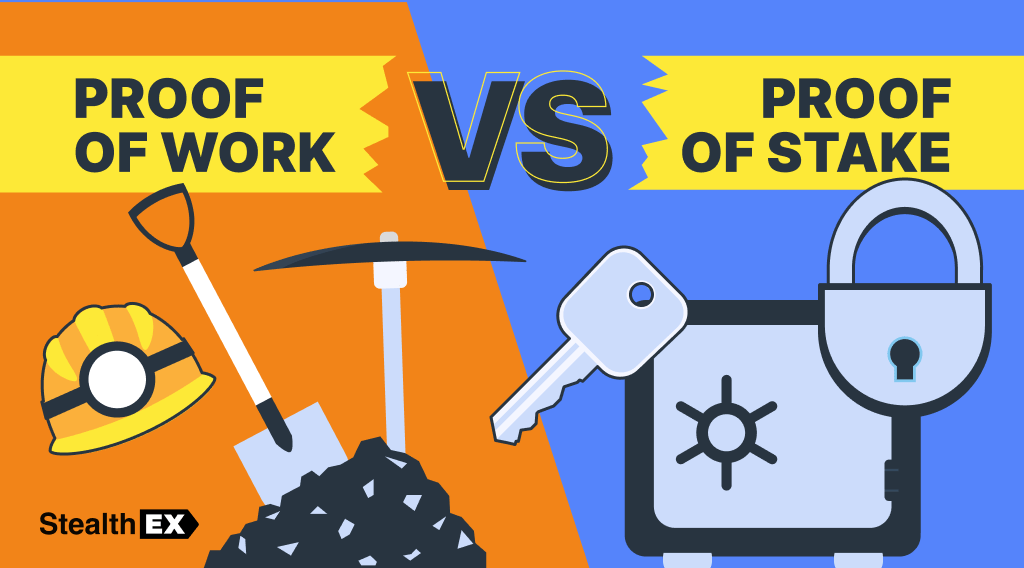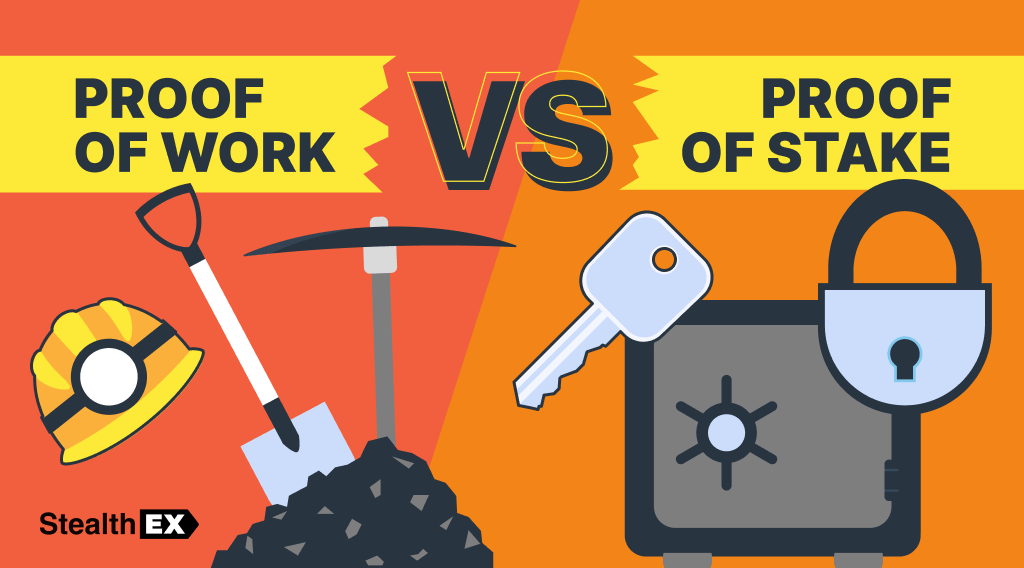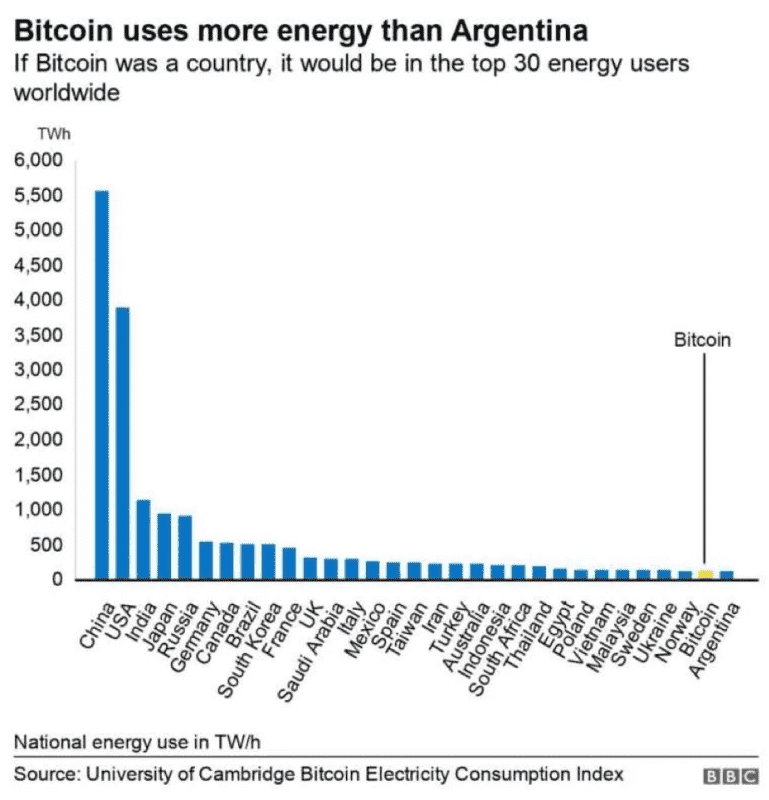Proof-of-Work vs Proof-of-Stake: What Is the Biggest Difference?

Proof-of-Work vs Proof-of-Stake. With the revolutionary technology known as blockchain, the digital world has entered a new phase of decentralization, transparency, and trust. Fundamentally, a distributed ledger is a safe and impervious to tampering database that is dispersed among a network of computers, or nodes. Blockchain functions on a decentralized consensus paradigm, enabling a network of participants to jointly validate and record transactions, in contrast to conventional centralized databases controlled by a single authority.
Now, one of the crucial building blocks of this relatively new technology is a so-called ‘consensus mechanism.’ Consensus mechanisms are the protocols that govern how nodes within the blockchain network agree on the current state of the ledger. They are essential to preserving the blockchain’s stability and security. Notable consensus mechanisms include Proof-of-Work (PoW) and Proof-of-Stake (PoS), each with a distinct methodology. The main difference between PoW and PoS is that PoS relies on staking, while PoW relies on mining. With Ethereum having successfully transitioned to PoS, this consensus mechanism has garnered a lot of attention. In this article, we’ll further explore both consensus mechanisms and their role in modern blockchain technology.

Article contents
What Is Proof-of-Work (PoW) in Crypto?
Currently, the most widely used consensus method in the sector is proof of work. It decides which node in the blockchain network gets to add the next block and helps blockchains stay secure and synchronize blocks. Proof-of-work demands that nodes in the network solve a challenging mathematical problem in order to work or demonstrate their labor. The first node to solve the problem and validate the transaction gets rewarded with cryptocurrency.
The process of solving mathematical problems to add blocks to a network is referred to as mining. As previously stated, nodes, or miners, in a Proof-of-work network compete to solve a challenging mathematical puzzle. Cryptocurrency is awarded to the first miner to successfully solve the puzzle and validate the transaction. Proof-of-work is also used to secure networks and process transactions. PoW is used by the most well-known cryptocurrency, Bitcoin.
The primary advantage of PoW is its high level of security. Under PoW, a 51% attack is when an entity controls more than 50% of the miners in a network and uses that majority to alter the blockchain. PoW is considered to be highly secure because it requires a significant amount of computational power to confirm transactions and create new blocks.
However, PoW is not environmentally friendly due to its high energy consumption requirements. In actuality, the Bitcoin network uses more energy than Argentina as a whole, according to the Cambridge Bitcoin Electricity Consumption Index.

Moreover, due to the computational costs of solving puzzles, PoW consensus may have issues with scalability because it can only process a certain number of transactions per second. There may be longer confirmation delays and higher transaction costs.
What Does Proof-of-Stake (PoS) Mean in Crypto?
A more recent consensus technique called PoS seeks to solve the problem of PoW’s excessive energy usage. In PoS, validators are chosen to create new blocks based on the amount of cryptocurrency they hold and ‘stake’ in the network. Validators are incentivized to behave honestly because they stand to lose their staked coins if they act maliciously.
PoS’s energy efficiency is one of its key benefits. PoS networks use a great deal less energy than PoW networks because miners are not required to solve challenging mathematical challenges. Furthermore, because an attacker would need to obtain a sizable portion of the network’s coins in order to successfully carry out such an attack, PoS networks are less vulnerable to 51% attacks. Other great benefits include environmental friendliness and the potential for centralization.
Proof-of-stake was developed as an alternative to Proof-of-work because of concerns about:
- How much energy Proof-of-work uses.
- Its environmental impact.
- Its vulnerability to attacks.
- Questions about its scalability.
Proof-of-Work vs Proof-of-Stake: Comparison
It is possible to consider the distinctions between Proof-of-stake and Proof-of-work consensus algorithms after gaining a thorough understanding of each.
| Criteria | Proof-of-Work | Proof-of-Stake |
| Working | The validity of transactions is determined by solving cryptographic puzzles | Validity of transactions determined on the basis of ‘stake’ in the network |
| Probability of Mining | The probability of mining depends on computational work by the miner | The probability of validation of a new block depends on the number of coins a person holds |
| Energy Consumption | PoW is more energy-intensive because it requires miners to solve complex puzzles using high-powered computers, consuming a significant amount of energy | PoS requires much less energy since validators only need to hold crypto and be selected to create new blocks |
| Security | PoW is highly secure in terms of preventing 51% of attacks | While PoS is generally secure, there is a potential risk of a 51% attack if a single entity or a coalition of validators accumulates the majority of the stake |
| Decentralization | PoW is more decentralized because any user with computational power can join the network as a miner | Proof-of-Stake systems are vulnerable to centralization and capture because control of the network is determined solely by capital, which is far more centralized than labor and cheap energy |
| Speed | PoW is quite slow: it can handle 64 transactions per second | PoS blockchains are way more efficient and can process up to 100,000 transactions per second |
| Environmental Impact | PoW requires a lot of energy and is often criticized as being not environmentally friendly | Processes are less energy-intensive, and therefore PoS is comparatively more environmentally friendly |
| Scalability | PoW consensus may have issues with scalability because it can only process a certain number of transactions per second | PoS has the potential to be more scalable because the number of validators and their stakes can affect how quickly transactions are processed |
| Rewards | Rewards are given to the first miner successful in solving the cryptographic puzzle for every block | Validators do not receive any block reward and settle for network fees as their reward |
PoW pits nodes against one another in an endeavor to solve challenging mathematical puzzles, using computing effort as validation. PoS, on the other hand, takes ownership rather than processing power into account when validating transactions, relying on users with large network stakes. By prohibiting nefarious actions like double-spending, these consensus techniques guarantee that the blockchain network comes to a consensus and runs safely.
Numerous blockchain networks have implemented PoW and PoS in real-world settings. The original cryptocurrency, Bitcoin, uses Proof-of-work to reach consensus. Other well-known PoS-based cryptocurrencies are Cosmos, Tezos, and Cardano.
In order to enhance comprehension of the differences between PoW and PoS, let’s take a quick look at two case studies: PoW Bitcoin and PoS Ethereum (PoS transition). The PoW consensus method of Bitcoin has shown to be extremely safe; yet, its energy usage has sparked questions. By using less energy, Ethereum’s switch to PoS seeks to mitigate the negative environmental effects of mining. However, because it calls for meticulous coordination and the creation of new procedures, the transition presents difficulties and uncertainty.
Proof-of-Work and Proof-of-Stake: Future Implications
A blockchain network’s prospects for the future are crucial since they influence innovation and uptake. Both PoW and PoS have different implications for future development and growth.
Given that PoW has been tried and true for more than ten years, it is more developed and reliable than PoS. It has a devoted and enthusiastic community that upholds its principles and purpose. Additionally, it has a robust network effect that makes it difficult to rival or replace. PoW does, however, have certain restrictions and difficulties that may limit its potential in the future. These include its environmental impact, its scalability issues, its regulatory uncertainty, and its innovation stagnation.
Since PoS is still developing and improving, it is more inventive and adventurous than PoW. Its vibrant and varied community works to find solutions for PoW’s drawbacks and issues. It also has a great deal of potential and room to expand and develop in the future. PoS, however, is not without dangers and uncertainties that may have an impact on its future prospects. These comprise its adoption obstacles, complexity problems, governance difficulties, and security flaws. It is important to note that both mechanisms are still in their early stages and have not been fully tested. As such, it is hard to say which one is better.
FAQ
What Is the Difference Between PoS and PoW Security?
One of the most crucial components of a blockchain network is security, which guarantees the validity and irreversibility of transactions. Although they both offer a high level of security, Proof-of-work and Proof-of-stake are not without flaws. Five-one percent of attacks are prevented by PoW, making it more secure than PoS.
What Is Better: Proof-of-Stake or Proof-of-Work?
Both consensus models have different benefits and drawbacks. Proof-of-work is better suited for establishing trust in a distributed system, while Proof-of-stake is better suited for reducing the cost of maintaining that trust.
Why Is PoS Better Than PoW?
Proof-of-stake is better suited for situations where there is a need for fast and efficient transactions.
Is ETH Proof-of-Stake?
In 2022, Ethereum underwent one of its biggest transformations: the transition from a Proof-of-work to a Proof-of-stake consensus mechanism.
Is BTC a PoS or PoW?
The BTC follows the Proof-of-work consensus mechanism.
Why Is Proof-of-Stake Faster Than Proof-of-Work?
Compared to PoW, PoS enables higher throughput and faster transaction processing. This is true because PoS doesn’t require puzzle solving or processing capacity.
Conclusion
The cryptocurrency community is actively working to address energy-related problems related to the use of cryptocurrencies, and blockchain technology has enormous potential. Furthermore, environmental solutions in cryptocurrency shouldn’t solely rely on the consensus method a project chooses, even though many blockchains favor Proof-of-Stake over Proof-of-work.
It is clear that PoW and PoS are two different consensus mechanisms that have their advantages and disadvantages. Depending on the objectives and principles of the users and developers, they are appropriate for varying use cases and tastes. Since each of them has advantages and disadvantages, there is no obvious winner or loser in this contest. While proponents of PoS emphasize the possibility of energy savings in this specific context, Proof-of-work is not without advantages of its own. But for the time being, it’s evident that Proof-of-Stake consumes less energy, thus we can declare with confidence that it has less of an effect on the environment.
Make sure to delve deeper into the topic and explore its implications for blockchain technology and cryptocurrency ecosystems. In case you’d like to buy one or several cryptocurrencies that run either on PoW or PoS, you can always use StealthEX.
Just go to StealthEX and follow these easy steps:
- Choose the pair and the amount you want to exchange — for instance, BTC to ETH.
- Press the “Start exchange” button.
- Provide the recipient address to transfer your crypto to.
- Process the transaction.
- Receive your crypto coins.
Follow us on Medium, Twitter, Telegram, YouTube, and Publish0x to stay updated about the latest news on StealthEX and the rest of the crypto world.
Don’t forget to do your own research before buying any crypto. The views and opinions expressed in this article are solely those of the author.
Ethereum PoW PoS PoW proof-of-stake proof-of-workRecent Articles on Cryptocurrency
 Crypto News: BBVA Backs Bitcoin, Iran Loses $90M, Senate Passes Crypto Bill
Crypto News: BBVA Backs Bitcoin, Iran Loses $90M, Senate Passes Crypto Bill  Quant Price Prediction: How High Can QNT Crypto Go?
Quant Price Prediction: How High Can QNT Crypto Go? 